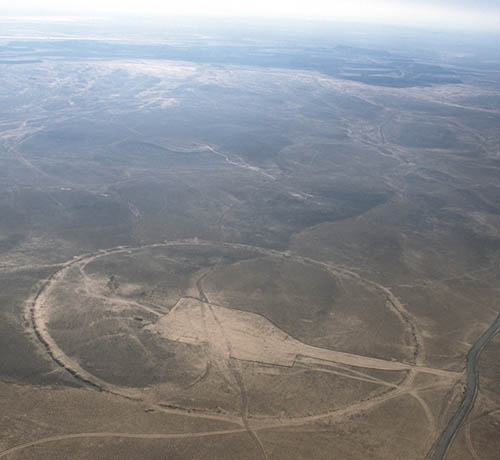>
Clonycavan Man: A 2,300-Year-Old Murder Mystery Epoch Times - October 28, 2014

In March 2003, the body of a man who lived during the Iron Age was discovered in a peat bog in Ireland. Known as the Clonycavan Man, the well-preserved remains indicate that the body was not that of a man who died a natural or honorable death, but one who was brutally murdered. The mysteries surrounding his death are plentiful. Who was this man? Why was he so brutally murdered? How was his body so well preserved for so many years? And what is the significance of his highly groomed hair?
Bog Bodies
Astronomical Find: One of the Earliest Greek Depictions of Constellations Live Science - October 27, 2014

A 2,600-year-old two-handled wine cup currently on display at the Lamia Archaeological Museum in Greece has long been thought to depict a random assortment of animals. But the piece of ancient pottery, called a skyphos,may actually contain one of the earliest Greek depictions of the constellations, a new analysis shows. The study researchers suggested that other ancient artistic representations of animals may also portray constellations, and hold clues to what the early Greeks knew about astronomy, said study researcher John Barnes, a classical archaeology doctoral candidate at the University of Missouri.
Photos: Is this the world's oldest secret code? Siberian Times - October 22, 2014
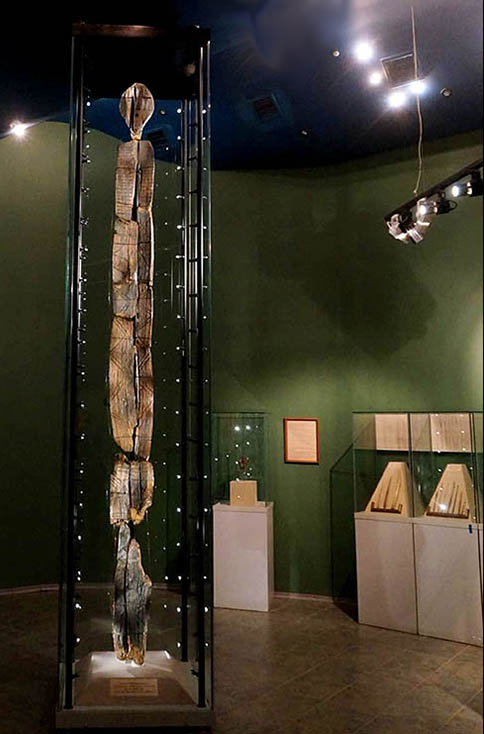
Side View and Close-up
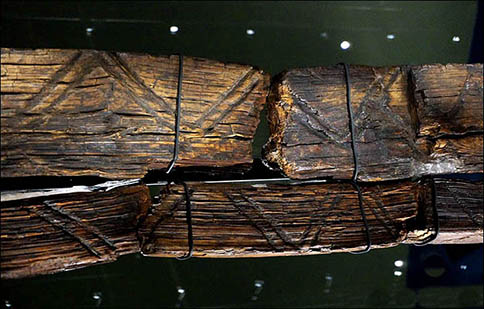
Scientists are close to precise dating of the Shigir Idol, twice as ancient as the Egyptian Pyramids. The Idol is the oldest wooden statue in the world, estimated as having been constructed approximately 9,500 years ago, and preserved as if in a time capsule in a peat bog on the western fringe of Siberia. Expert Svetlana Savchenko, chief keeper of Shigir Idol, believes that the structure's faces carry encoded information from ancient man in the Mesolithic era of the Stone Age concerning their understanding of 'the creation of the world'. German scientists are now close to a precise dating - within five decades - of the remarkable artifact, which is a stunning example of ancient man's creativity. The results are likely to be known in late February or early March, The Siberian Times can reveal. Now the question is turning among academics to a better understanding of the symbols and pictograms on this majestic larch Idol, one of Russia's great treasures, which is now on display a special glass sarcophagus at its permanent home, Yekaterinburg History Museum, where Savchenko is senior researcher.
The Last Hieroglyphic Language on Earth and an Ancient Culture Fighting to Survive Epoch Times - October 22, 2014

The Dongba symbols are an ancient system of pictographic glyphs created by the founder of the Bon religious tradition of Tibet and used by the Naxi people in southern China. Historical records show that this unique script was used as early as the 7th century, during the early Tang Dynasty, however, research conducted last year showed that its origins may date back as far as 7,000 years ago. Incredibly, the Dongba symbols continue to be used by the elders of the Naxi people, making it the only hieroglyphic language still used in the world today. The Naxi people lived in the beautiful mountain province of Yunnan (“south of the clouds”) for thousands of years, where they developed their own rich and enduring culture. Today, most of the 270,000 Naxi people live in the county of Lijiang where they retain many of their ancient traditions.
Languages and Scripts
Naxi Language Wikipedia
Naxi People Wikipedia
Mysterious 4,000-Year-Old 'CD-ROM' Code Cracked Discovery - October 23, 2014

A fired-clay disk from the Second Millenium B.C. may finally have had some of its markings decoded. The mysterious Phaistos Disk found in 1908 in a palace called Phaistos on the island of Crete, contains symbols on both sides, in a spiral configuration meant to be read from the outside toward the center. It is estimated to date from about 1,700 B.C. For better than a century, scientists have been trying to decode the meaning behind the symbols, and now Dr. Gareth Owens, of the Technological Educational Institute of Crete, says he has figured out some of its keywords and the general message it conveys. Using specific groups of symbols Owens says one side of the disk contains the translated wording "great lady of importance" while the other uses the expression "pregnant mother." One side, Owens says, is dedicated to a pregnant woman and the other to a woman giving birth.
Missing Sphinx Head Found in Ancient Greek Tomb Live Science - October 22, 2014

Archaeologists have discovered the missing head of one of the two marble sphinxes guarding a huge Macedonian tomb under excavation in Amphipolis, Greece. The statue's head has wavy hair that falls to its left shoulder, and it bears traces of red paint, according to an update yesterday (Oct. 21) from the Greek Ministry of Culture. Excavators also found fragments of the broken wings from the pair of sphinxes that stand at the entrance of the tomb. Enclosed by a marble wall 1,600 feet (490 m) in perimeter, the monumental burial mound at Amphipolis in northern Greece could be the largest of its kind in the Greek world. The archaeologists leading the ongoing excavation have not yet determined who is buried in the tomb (or if it is even intact), but they have said they believe the complex dates back to the fourth century B.C., during the era of Alexander the Great.
Alexander the Great
Sphinx Files
Ancient Greece
 King Tut's 'virtual autopsy' reveals surprises CNN - October 22, 2014
King Tut's 'virtual autopsy' reveals surprises CNN - October 22, 2014

King Tutankhamun's golden, mummified remains tell only a partial story of an ancient Egyptian boy king who died under mysterious circumstances.
King Tut
Mummies
Ancient Egypt
Rare Inscription Hailing Emperor Hadrian Unearthed in Jerusalem Live Science - October 21, 2014

A newly uncovered large slab of limestone with an official commemoration to the Roman Emperor Hadrian may help researchers understand the events that led to the Bar Kokhba revolt in the early second century, experts said. The finding is both rare and tremendous, and may be one of the most important Latin inscriptions ever uncovered in Jerusalem, the researchers said. Yet, the fragmented stone served more than one purpose throughout the ages. After ancient officials inscribed the commemoration, others recycled the limestone and used it to build a cistern, a container for storing water.
Hadrian
Ancient Rome
In Photos: Prehistoric Temple Uncovered in Ukraine Live Science - October 20, 2014
The temple measures 60 by 20 meters (197 by 66 feet) and was made of wood and clay. Originally two stories tall it was surrounded by a galleried courtyard. The temple and settlement were burned down after they were abandoned. (Photo Credit: courtesy Nataliya Burdo and Mykhailo Videiko/Institute of Archaeology NAS of Ukraine, Kyiv.)
Ancient City Ruled by Genghis Khan's Heirs Is Unearthed in Russia NBC - October 25, 2014
Remains of a 750-year-old city, founded by the descendants of Genghis Khan, have been unearthed along the Volga River in Russia. Among the discoveries are two Christian temples, one of which has stone carvings and fine ceramics. The city's name was Ukek and it was founded just a few decades after Genghis Khan died in 1227. After the great conqueror's death, his empire split apart and his grandson Batu Khan, who lived from 1205 to 1255, founded the Golden Horde (also called the Kipchak Khanate). The Golden Horde kingdom stretched from Eastern Europe to Central Asia and controlled many of the Silk Road trade routes that connected China to Medieval Europe.
US returns smuggled ancient artifacts to Peru BBC - October 24, 2014

The US has returned about 20 ancient artifacts - some more than 1,800 years old - to Peru. The objects include pottery and pieces looted from ancient Peruvian graves dating back from before the arrival of the Spanish in the 16th Century. They were found during four separate investigations over several years by US the customs service.
Inca
High-Tech Drones Give Archaeologists a Bird's-Eye View of the Past NBC - October 25, 2014
Maybe all Indiana Jones needed was a good hat and a whip, but if he'd seen what archaeologists are using these days, even he might be jealous. From drones that perform high-fidelity 3-D scans to apps that automatically scour satellite data for undiscovered sites, the past has never looked more futuristic.
Two World War II Battle Ships Discovered Off North Carolina Live Science - October 22, 2014
Two World War II vessels that sunk within moments of each other 72 years ago have been rediscovered on the floor of the Atlantic Ocean, resting only a few hundred yards apart. The Allied merchant freighter Bluefields and the German U-boat U-576 went down on July 15, 1942, part of the larger Battle of the Atlantic that raged throughout the war. The shipwrecks were found by a team of researchers from the National Oceanic and Atmospheric Administration (NOAA) and the Bureau of Ocean Energy Management.
DNA yields secrets of human pioneer BBC - October 23, 2014
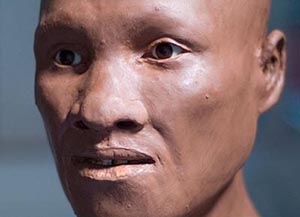
DNA analysis of a 45,000-year-old human has helped scientists pinpoint when our ancestors interbred with Neanderthals. The genome sequence from a thigh bone found in Siberia shows the first episode of mixing occurred between 50,000 and 60,000 years ago. The male hunter is one of the earliest modern humans discovered in Eurasia. The study in Nature journal also supports the finding that our species emerged from Africa some 60,000 years ago, before spreading around the world. The analysis raises the possibility that the human line first emerged millions of years earlier than current estimates.
Early Humans
Neanderthals and Humans First Mated 50,000 Years Ago, DNA Reveals Live Science - October 23, 2014
The DNA from the 45,000-year-old bone of a man from Siberia is helping to pinpoint when modern humans and Neanderthals first interbred, researchers say. Although modern humans are the only surviving human lineage, others once lived on Earth. The closest extinct relatives of modern humans were the Neanderthals, who lived in Europe and Asiauntil they went extinct about 40,000 years ago. Recent findings revealed that Neanderthals interbred with ancestors of modern humans when modern humans began spreading out of Africa - 1.5 to 2.1 percent of the DNA of anyone living outside Africa today is Neanderthal in origin.
Neanderthal
Out of Africa
Myth Busted: Ancient Humans May Not Have Been Redheads Live Science - October 22, 2014

Ancient humans found with red hair weren't necessarily redheads in life, but may have acquired their carrot tops after death, a new study finds. A team of researchers examined the processes that degrade locks, ranging from exposure to the sun's powerful rays or being eaten away by microbes. These processes, many of which begin while a person or animal is still alive, can leave hair with an unnatural, reddish hue. The findings are not only important for archaeology, but also for conservation efforts and forensic investigations, according to the study published Oct. 21 in the journal Proceedings of the Royal Society B.
 'The Hobbit' turns 10: Find that rewrote human history BBC - October 20, 2014
'The Hobbit' turns 10: Find that rewrote human history BBC - October 20, 2014

The claim is made by Prof Richard Roberts who was among those to have published details of the "Hobbit". The early human was thought to have lived as recently as 20,000 years ago and so walked the Earth at the same time as our species. The Hobbit's discovery confirmed the view that the Earth was once populated by many species of human.
Hobbit

Swimming Mammoths Beat Humans to California Live Science - October 23, 2014
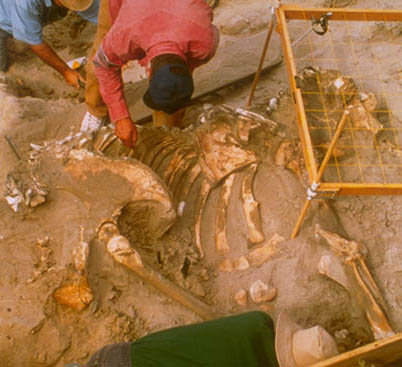
A fossil tusk rescued from the sea proves mammoths swam to Southern California's Channel Islands much earlier than thought. The new fossil is one of two recently discovered tusks that challenge the idea that climate change killed off the Channel Islands' pygmy mammoths. The pint-size beasts disappeared from the islands about 12,000 years ago. Most researchers blame either the Earth's warming climate or the arrival of humans on the islands for the mammoth's demise, he said. But pygmy mammoths likely survived a steamier, more severe climate swing about 125,000 years ago.
Mammoths
Mystery of dinosaur with giant arms solved BBC - October 22, 2014

For half a century, all that was known about this dinosaur was that it had enormous forearms, measuring 2.4m-long (8ft) and tipped with three giant claws. Its name Deinocheirus mirificus means unusual, horrible hands. In various reconstructions, it has been imagined as anything from a T. rex-type predator grasping at prey with its claws, to a giant, sloth-like climber, using its arms to dangle from trees. But the discovery of two nearly complete skeletons in Mongolia have finally laid this speculation to rest. The international research team says the beast was very large, measuring about 11m (36ft) long and weighing six tons. It had an elongated head with a duck-like beak, and a large humped sail on its back.
Dinosaurs
Giant, Extinct Kangaroos Probably Didn't Hop Live Science - October 15, 2014

The ancestors of modern-day kangaroos, giant marsupials with rabbitlike faces, may have walked upright on two feet, sans any hopping, a new study finds. These enormous creatures, part of the extinct family of sthenurine kangaroos, once roamed the Australian outback from about 100,000 to 30,000 years ago. But they were likely bad hoppers, said lead researcher Christine Janis, a professor of ecology and evolutionary biology at Brown University in Rhode Island.
Paleontology: Marsupials, Kangaroo
PALEONTOLOGY
ARCHEOLOGY
ELLIE'S ARCHIVES 2014
ELLIE'S ARCHIVES
ALPHABETICAL INDEX
CRYSTALINKS HOME PAGE
PSYCHIC READING WITH ELLIE
BOOK: THE ALCHEMY OF TIME
DONATION TO CRYSTALINKS
ADVERTISE ON CRYSTALINKS
